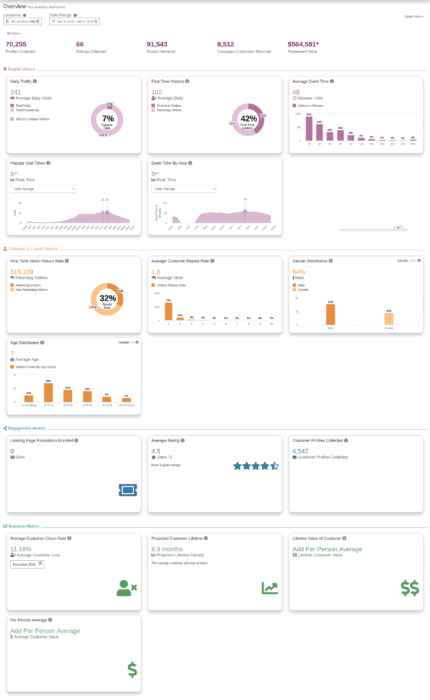
Today’s restaurant industry is ultra-competitive, so finding any way possible to decrease costs and increase guest loyalty should always be top-of-mind for restaurant operations teams. However, the only way to be as efficient as possible when it comes to your restaurant operations is to have solid, reliable customer data with which you can make intelligent, data-driven decisions.
Thanks to the rise of WiFi technology, you can now have access to the type of data you need to make these types of decisions. While most WiFi technology is focused on only Wifi marketing tools to do marketing in your restaurant, Wifi analytics provides a set of key performance indicators (KPIs) that show your organization how to improve restaurant operations by measuring your customers’ behavior at your locations. This is very much like Google analytics but for your physical location.

How WiFi Analytics Can Help Improve Restaurant Operations
WiFi analytics give restaurant owners and operators the ability to gather valuable data centered around the activity and behavior of their actual customers. This makes forecasting traffic and scheduling staff easier. It also gives you data to identify trouble areas quickly. Showing you data such as dwell time by hour or how long someone stays at your location when they come in at a specific time, like 10 a.m. For instance, if your normal dwell time or table turn time is 30 minutes, but at 10 am it’s 60 minutes, you might have a staffing issue you need to address.
Every WiFi-enabled device, such as a cell phone, tablet or laptop, is constantly sending out a signal that is searching for a WiFi access point. This signal contains a unique identifying number, exclusive to each device.
At the same time, your restaurant’s WiFi access point is constantly “listening” for any device that comes into range. When a device is identified it is logged into a database, identified by its unique identifying number.
Even if your guests do not log into your WiFi, you have the ability to collect anonymous behavior data on every guest carrying a device. With this kind of data, you can immediately begin forecasting and scheduling with much more accuracy.
If your guests do attempt to log into your WiFi, they will be required to enter their email address to gain access to the internet. At this point, a customer profile is created. Any previous and future data will be added to the customer profile, allowing you to make smarter restaurant marketing decisions, as well.
What Key Performance Indicators (KPIs) Will You Have Access To?
 With a WiFi analytics platform installed at your place of business, you’ll have a large amount of data very quickly. This data will be from a very large sample size of your actual customers. You’ll see valuable KPIs that can easily be applied to your operations decisions, such as:
With a WiFi analytics platform installed at your place of business, you’ll have a large amount of data very quickly. This data will be from a very large sample size of your actual customers. You’ll see valuable KPIs that can easily be applied to your operations decisions, such as:
- Customer Dwell Times, and Dwell Times by Hour
- Daily Customers vs. Passers-by
- First-time Visitors
- First-time Visitor Return Rate
- Popular Visit Times
- Projected Lifetime Visits
- Customer Churn Rates
- Customer Repeat Rates, and more
You’ll see these KPIs updated in real-time. It is the most accurate and reliable market research you can obtain. Likewise, it comes at a fraction of the cost of other data collection methods.
If you operate multiple locations, you can use the data to compare traffic and dwell times of different locations. You can also use the data to help make more efficient staffing, purchasing, and preparation decisions.
Purchasing
To run a successful restaurant, it is imperative to have the inventory on-hand to fill customer orders. Back-of-house purchasing can be a tricky thing. You want to make sure you have enough food items in inventory to complete all of your orders without 86’ing menu items, even the rarely ordered items. At the same time, you need to make sure that you do not over-purchase, resulting in spoiling of food items and an unnecessary loss of money.
This also goes for drink items, paper items and essential miscellaneous items.
Having a good understanding of how many customers are visiting, at what time, and how they’re behaving at your establishment, it becomes much easier to make the kind of accurate purchasing decisions necessary to maintain a lean and profitable business.
Food Preparation
Much like purchasing, food preparation is an important part of running a smooth and successful restaurant. Food items, such as vegetables or sauces, need to be prepared in advance of busy times. Some restaurants will also prepare special menu items for customers with allergies, or those who might have special requests. You can cook and present menu items much quicker than doing everything when the order comes in.
With accurate and reliable customer data acquired from a WiFi analytics platform, it becomes much easier to prepare the right number of items before the busy shift begins. This helps ensure that you are not under-preparing, leading to chaos when things need to be prepared on the fly. Likewise, it keeps you from over-preparing which can lead to spoilage and waste.
Staffing
 Restaurant operations are at the center of your everyday focus. You can have the best food and environment in the world, but if you’re understaffed, your customers will most likely have a negative experience. Customers expect to be greeted at the door, seated quickly, have orders taken in a reasonable amount of time, and be treated politely and respectfully.
Restaurant operations are at the center of your everyday focus. You can have the best food and environment in the world, but if you’re understaffed, your customers will most likely have a negative experience. Customers expect to be greeted at the door, seated quickly, have orders taken in a reasonable amount of time, and be treated politely and respectfully.
When you are understaffed, your servers will undoubtedly be very busy and reasonably flustered. This does not bode well with what customers expect out of a successful restaurant. But at the same time, over-staffing can cause huge and unnecessary costs.
Having accurate historical data that can be filtered and sorted by date and time can help tremendously. Staffers will have a much easier time ensuring that the proper amount of staff is on-hand. They will also be able to relieve servers from duty at the most opportune times.
Benchmarking
When you analyze your restaurant’s measurements against the industry benchmarks, you can begin to see the areas in which your restaurant could use improvement, as well as where you are succeeding. You can then apply more focus and resources on things requiring improvement. Likewise, you can work to cement the successful areas and make them even better.
Your team can then brainstorm ways in which to close the performance gaps. Then, you can make corrections and take measurements on a consistent basis to verify a move in the correct direction. You would then take steps to continue to monitor and iterate on your success strategy over time.
Traditional benchmarks are still used and esteemed by most restaurants today, however, new benchmarks are now being used. These include things like third-party delivery benchmarks and customer behavior benchmarks. The latter can only be accessible using a WiFi analytics platform like DIGIMAX Intelligence. Read more here: Restaurant Operations Benchmarks.
DIGIMAX Intelligence Restaurant Growth Tools
To learn more about the ways the DIGIMAX Intelligence WiFi marketing & analytics growth tools can help you improve your restaurant operations to drive more sales, improve overall customer experience, measure customer sentiment and grow your business, schedule a free demo today.
 Skip to content
Skip to content
